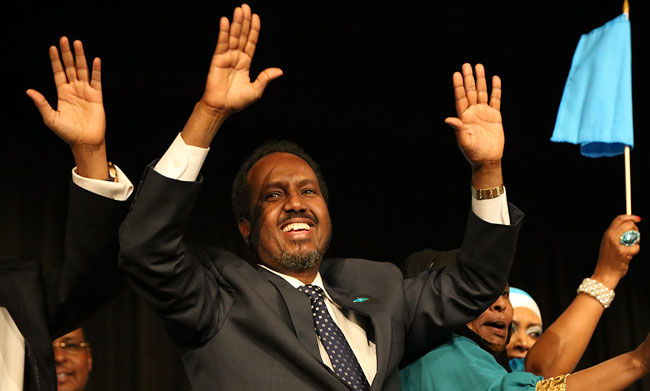Somalia: Somalia Government Profile 2013
2013/08/17

no permanent national government; transitional, parliamentary federal government
18 regions (plural - NA, singular - gobolka); Awdal, Bakool, Banaadir, Bari, Bay, Galguduud, Gedo, Hiiraan, Jubbada Dhexe, Jubbada Hoose, Mudug, Nugaal, Sanaag, Shabeellaha Dhexe, Shabeellaha Hoose, Sool, Togdheer, Woqooyi Galbeed
1 July 1960 (from a merger of British Somaliland, which became independent from the UK on 26 June 1960, and Italian Somaliland, which became independent from the Italian-administered UN trusteeship on 1 July 1960, to form the Somali Republic)
Foundation of the Somali Republic, 1 July (1960); note - 26 June (1960) in Somaliland
25 August 1979, presidential approval 23 September 1979 note: the formation of transitional governing institutions, known as the Transitional Federal Government, is currently ongoing
no national system; a mixture of English common law, Italian law, Islamic sharia, and Somali customary law; accepts compulsory ICJ jurisdiction with reservations
18 years of age; universal
unicameral National Assembly note: unicameral Transitional Federal Assembly (TFA) (550 seats; 475 members appointed according to the 4.5 clan formula, with the remaining 75 seats reserved for civil society and business persons)
following the breakdown of the central government, most regions have reverted to local forms of conflict resolution, either secular, traditional Somali customary law, or Sharia (Islamic) law with a provision for appeal of all sentences
None
other: numerous clan and sub-clan factions exist both in support and in opposition to the transitional government
ACP, AfDB, AFESD, AMF, AU, CAEU, FAO, G-77, IBRD, ICAO, ICRM, IDA, IDB, IFAD, IFC, IFRCS, IGAD, ILO, IMF, IMO, Interpol, IOC, IOM, IPU, ITSO, ITU, LAS, NAM, OIC, UN, UNCTAD, UNESCO, UNHCR, UNIDO, UPU, WFTU, WHO, WIPO, WMO
although an interim government was created in 2004, other regional and local governing bodies continue to exist and control various regions of the country, including the self-declared Republic of Somaliland in northwestern Somalia and the semi-autonomous State of Puntland in northeastern Somalia
- Somalia News
-
- DJIBOUTI CITY: East Africa moves to curb used car imports, boost local assembly plants
- BOTSWANA: Routes Africa forum aims to improve African air connectivity
- BOTSWANA: Economic integration is helping boost trade and investment in Africa
- BOTSWANA: Africa’s economic growth is likely to be slower in the intervening years
- BOTSWANA: Beyond Commodities: How African Multinationals Are Transforming
- DJIBOUTI CITY: East Africa trading bloc ranked high in regional integration
- Trending Articles
-
- AUSTRALIA: Australia taxes foreign home buyers as affordability bites
- SERBIA: China’s Xi sees Serbia as milestone on new ‘Silk Road’
- CHINA: United States sees China investment talks ‘productive’ after new offers
- INDIA: Indian central bank chief to step down in surprise move
- THAILAND: Foreign investment plummets in junta ruled Thailand
- UNITED STATES: Trump says Britain should leave EU


